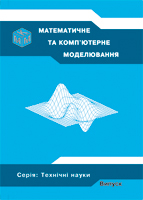Про контроль числових результатів в задачах ідентифікації динамічних об'єктів енергетичного призначення
DOI:
https://doi.org/10.32626/2308-5916.2022-23.45-55Анотація
У статті запропоновано підхід до вирішення актуальної задачі контролю отриманих результатів при побудові та реалізації алгоритмів ідентифікації енергетичних об'єктів на основі інтегральних динамічних моделей. Розглянутий метод, заснований на використанні алгоритмів квадратури і сплайнів для апроксимації ядра, з переходом до розв’язування рівнянь з виродженим ядром за рекурентними формулами, показав достатню ефективність при розв’язуванні задачі отримання високої швидкодії при наявності контролю точності розрахунку параметрів інтегральної динамічної моделі, а також забезпечення стійкості до похибок експериментальних даних. Запропонований метод дозволяє вирішити проблему накопичення обчислень, що, в свою чергу, приводить алгоритм чисельної реалізації до такого вигляду, при якому можливе отримання розв’язків в режимі реального часу. Отримані інтегральні моделі володіють достатнім рівнем адекватності та можуть використовуватись в інтегрованих обчислювальних системах керування об’єктів енергетичного призначення
Посилання
Verlan A. A. Analysis of the diagnosability of objects with a rebuildable structure. Collection of scientific works «Modeling and Information Technologies». Kyiv, 2008. Vol. 45. Р. 3-9.
Richard C. Dorf, Robert H. Bishop. Modern Control Systems, 14th edition. Pearson, 2021.
Dubovoy V. M. Identification and modeling of technological objects and control systems. Vinnitsa, 2012. 308 p.
Dubovoy V. M. Modeling of control and management systems. Vinnytsia, 2005. 174 p.
Doyle F. J., Pearson R. K., Ogunnaike B. A. Identification and Control Using Volterra Models. Communications and Control Engineering. 2002. DOI: 10.1007/978-1-4471-0107-9.
Verlan A. F., Verlan A. A., Horoshko I. O. and others. Algorithmic foundations of the integral method of dynamic objects’ identification. Integral methods and computer tools for solving problems of modelling complex dynamic systems. Mathematical methods and computer tools for increasing the resolving power of systems of technological control and management of energy-generating equipment: Final report 0103U000218. Kyiv, 2006. Ch. 3, 5. P. 120-146, 200-231.
Verlan A. A., Osman I. Kh. Method of identification experiments for diagnosing electronic devices. Collection of scientific works. G. E. Pukhov IMEE. NAS Ukrainy. Kyiv, 2007. Vol. 42. Р. 98-105.
Verlan A. A., Gazi A. Algorithm of identification of continuous objects on the basis of integral dynamic models. Collection of scientific works «Modeling and Information Technologies». 2003. Vol. 25. P. 105-112.
Brunner H. Volterra integral equations: an introduction to theory and applications. Cambridge University Press. 2017. Vol. 30. DOI: 10.1017/9781316162491.
Isermann R., Munchhof M. Identification of Dynamic Systems. An Introduction with Applications. Springer-Verlag, 2011. 711 p.
Charles L. Byrne. Signal Processing: A Mathematical Approach, Second Edition. Chapman & Hall/CRC Monographs and Research Notes in Mathematics, 2nd Edition. 2014. 439 p.
Verlan A. F., Abdusatarov B. B., Ignatchenko A. A., Maksimovich N. A. Methods and devices for interpreting experimental dependencies in the study and control of energy processes. Kyiv: Nauk. dumka, 1993. 208 p.
##submission.downloads##
Опубліковано
Номер
Розділ
Ліцензія
Authors who publish with this journal agree to the following terms:- Authors retain copyright and grant the journal right of first publication with the work simultaneously licensed under a Creative Commons Attribution License that allows others to share the work with an acknowledgement of the work's authorship and initial publication in this journal.
- Authors are able to enter into separate, additional contractual arrangements for the non-exclusive distribution of the journal's published version of the work (e.g., post it to an institutional repository or publish it in a book), with an acknowledgement of its initial publication in this journal.
- Authors are permitted and encouraged to post their work online (e.g., in institutional repositories or on their website) prior to and during the submission process, as it can lead to productive exchanges, as well as earlier and greater citation of published work (See The Effect of Open Access).

